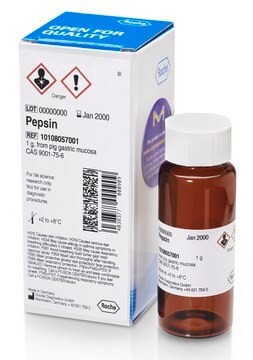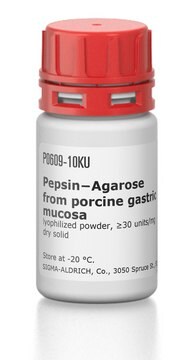SRE0001
Pepsin from porcine gastric mucosa
Suitable for manufacturing of diagnostic kits and reagents, lyophilized powder, ≥3200 units/mg protein
Synonym(s):
Pepsin A, Pepsin from hog stomach
Sign Into View Organizational & Contract Pricing
All Photos(5)
About This Item
Recommended Products
Quality Level
form
lyophilized powder
specific activity
≥3200 units/mg protein
mol wt
35 kDa
impurities
salt, essentially free
color
white to off-white
UniProt accession no.
application(s)
diagnostic assay manufacturing
shipped in
wet ice
storage temp.
−20°C
Gene Information
pig ... LOC396892(396892)
Looking for similar products? Visit Product Comparison Guide
Application
Pepsin cleavage can be used to produce F(ab′)2 fragments of antibodies. pepsin at www.sigma-aldrich.com/enzymeexplorer.
Biochem/physiol Actions
Preferential cleavage: hydrophobic and aromatic residues in P1 and P1′ postitions. Cleaves Phe-Val, Gln-His, Glu-Ala, Ala-Leu, Leu-Tyr, Tyr-Leu, Gly-Phe, Phe-Phe and Phe-Tyr bonds in the β chain of insulin
Unit Definition
One unit will produce a ΔA280 of 0.001 per min at pH2.0 at 37° C, measured as TCA-soluble products using hemoglobin as substrate. (Final volume = 16mL. Light path = 1cm.)
Analysis Note
Optimum pH is 2-4. Active in 4 M urea and 3 M guanidine HCl. Stable at 60 °C. Pepsin is irreversibly inactivated at pH 8.0 - 8.5.
Protein determined by E1%/280
Other Notes
View more information on pepsin at www.sigma-aldrich.com/enzymeexplorer.
inhibitor
Product No.
Description
Pricing
Signal Word
Danger
Hazard Statements
Precautionary Statements
Hazard Classifications
Eye Irrit. 2 - Resp. Sens. 1 - Skin Irrit. 2 - STOT SE 3
Target Organs
Respiratory system
Storage Class Code
11 - Combustible Solids
WGK
WGK 1
Flash Point(F)
Not applicable
Flash Point(C)
Not applicable
Choose from one of the most recent versions:
Already Own This Product?
Find documentation for the products that you have recently purchased in the Document Library.
Customers Also Viewed
J A Green et al.
Reviews of reproduction, 3(1), 62-69 (1998-03-24)
The pregnancy-associated glycoproteins (PAGs) were first described as placental antigens of cattle that were also present in the blood serum of the mother after implantation. Molecular cloning studies have shown that they are members of the aspartic proteinase gene family
Joseph S Fruton
The Quarterly review of biology, 77(2), 127-147 (2002-07-02)
Studies on gastric digestion during 1820-1840 led to the discovery of pepsin as the agent which, in the presence of stomach acid, causes the dissolution of nutrients such as meat or coagulated egg white. Soon afterward it was shown that
J Tack
Alimentary pharmacology & therapeutics, 22 Suppl 1, 48-54 (2005-07-27)
Gastro-oesophageal reflux disease is defined as the presence of symptoms or lesions that can be attributed to the reflux of gastric contents into the oesophagus. Aspiration and prolonged monitoring studies in humans have shown that reflux of gastric contents is
B I Hirschowitz
The Yale journal of biology and medicine, 72(2-3), 133-143 (2000-04-26)
Esophagitis results from excessive exposure of the esophagus to gastric juice through an ineffective or dysfunctional lower esophageal sphincter mechanism. A possible role of pepsin in damaging the esophageal mucosa with consequent esophagitis may be examined directly by testing pepsin
Autonomic control of secretion of gastric acid and pepsin.
K Bech
Journal of autonomic pharmacology, 9(6), 419-428 (1989-12-01)
Our team of scientists has experience in all areas of research including Life Science, Material Science, Chemical Synthesis, Chromatography, Analytical and many others.
Contact Technical Service








